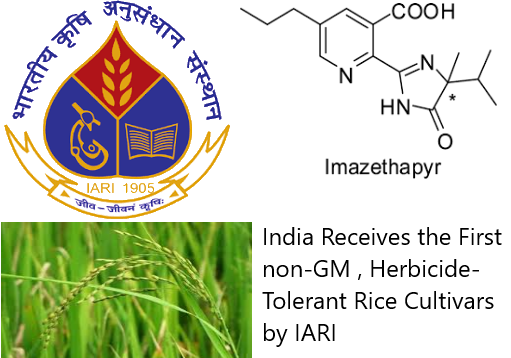Summary :-
- The varieties — Pusa Basmati 1979 and Pusa Basmati 1985 — contain a mutated acetolactate synthase (ALS) gene making it possible for farmers to spray Imazethapyr, a broad-spectrum herbicide, to control weeds.
- Imazethapyr, used to remove broadleaf, grassy and sedge weeds cannot be used on normal rice varieties as it cannot distinguish between weeds and crops and might end up destroying paddy. But for the new varieties with its ALS gene the herbicide binds with the enzymes produced inhibiting production of amino acids. This mechanism is called herbicide-tolerance through mutation breeding . There is no involvement of a foreign gene
- At the ICAR-National Rice Research Institute , this herbicide-tolerant gene has been introgressed in four popular rice varieties, (Sahbhagidhan, Naveen, SwarnaSub1 and Pooja) and are currently under national testing.
The Indian Agricultural Research Institute (IARI) has developed the country’s first-ever non-GM (genetically modified) herbicide-tolerant rice varieties that can be directly seeded and significantly save water and labour compared to conventional transplanting.
A non-Genetically Modified (GM) rice variety that is tolerant to herbicide use, indigenously made in India is a reality now. The Indian Agricultural Research Institute has come up with two varieties of these rice-Pusa basmati 1979 and Pusa Basmati 1985that can be directly seeded, need less money and labour for planting compared to conventional rice farming.
Both the varieties contain a mutated acetolactate synthase (ALS) gene helping farmers to spray Imazethapyr, a broad-spectrum herbicide, to control weeds. Both he varieties were launched by the PM .
For conventional paddy cultivation farmers need to transplant the seed after which they are “puddled” and tilled in standing water . The plants are irrigated frequently for the first three weeks to maintain water depth of 4-5 cm. Watering the plant is required every alternate day in the next four-five weeks during the stem development stage, making rice farming labour and water intensive. In this new rice variety with Imazethapyr, the requirement of transplanting, nursery puddling and flooding fields is removed and they can be sowed directly just like wheat, A K Singh, director of IARI informed.
About Mutated Acetolactate Synthase (ALS)
Acetolactate synthase (ALS) is the first common enzyme in the biosynthetic pathway of branched-chain amino acids. Mutations of specific amino acids in ALS have been known to confer resistance to ALS-inhibiting herbicides such as sulfonylureas and pyrimidinyl carboxy (PC) herbicides.

Trp548Met mutation of acetolactate synthase in rice confers resistance to a broad spectrum of ALS-inhibiting herbicides.
Genetic alteration of cultivated rice can enhance its tolerance to certain herbicides, so that the corresponding herbicides can selectively kill weedy rice without harming the cultivated rice. At present, researchers have obtained various herbicide-resistant rice lines through transgenics, gene editing, and mutant screening.
Identification of mutation sites in ALS gene by sequencing
Genomic DNA was extracted from herbicide resistant mutants using the CTAB method . PCR primers (5′-CCATCCGAGCCACACATCGCCTC-3′ and 5′-ACAAACATCATAGGCATACCACTC-3′) were designed according to the ALS cDNA sequence (accession number AB049822). The ALS gene in each mutant was amplified by PCR. The PCR products were separated by agarose gel electrophoresis, and the target band was extracted from the gel for DNA sequencing. DNASTAR software was used for DNA sequence alignment to identify the mutation site.
About Imazethapyr

Imazethapyr structure
- Description -Imazethapyr is an aromatic carboxylic acid and a member of pyridines.Imazethapyr SL Herbicide is a selective herbicide that can be applied as an early pre-plant, pre-plant incorporated, pre-emergent or post-emergent treatment in soybeans. The application method depends upon the crop, anticipated weed spectrum and the preference of the applicator.
- IUPAC: 5-ethyl-2-(4-methyl-5-oxo-4-propan-2-yl1H-imidazol-2-yl)pyridine-3-carboxylic acid
- Classes: HRAC: B
- CAS RN: 81335-77-5
- CHEMICAL CLASS: Als Herbicides (Imidazolinone Herbicides) [1]
Indication: Herbicides - MOA -The mode of action of imazethapyr is the inhibition of acetolactate synthase (ALS) (Shaner et al., 1984), the first common enzyme in the biosynthesis of the branched-chain amino acids valine, leucine, and isoleucine (Saari and Mauvais, 1996).
About The Indian Agricultural Research Institute
The Indian Agricultural Research Institute (IARI), commonly known as the Pusa Institute, is India’s national institute for agricultural research, education and extension. The name Pusa Institute is derived from the fact that the institute was originally located in Pusa, Bihar as the Imperial Institute of Agricultural Research in 1911. It was then renamed as the Imperial Agricultural Research Institute in 1919 and following a major earthquake in Pusa, it was relocated to Delhi in 1936. The current institute in Delhi is financed and administered by the Indian Council of Agricultural Research (ICAR). The IARI was responsible for the research leading to the “Green Revolution in India” of the 1970s.
ChemRobotics is a scientific data science company that specializes in serving the Pharmaceutical, Agrochemical, Veterinary, and Fine Chemical sectors. It offers an extensive online database that provides a wide range of scientific data to professionals in these industries. The ChemRobotics database proves to be invaluable to various teams involved in product development, including chemists, formulation scientists, biologists, and the registration team. Moreover, the ChemRobotics database offers numerous benefits to the generic/discovery agrochemical industry, making it an essential resource. Weblink: https://www.chemrobotics.com


